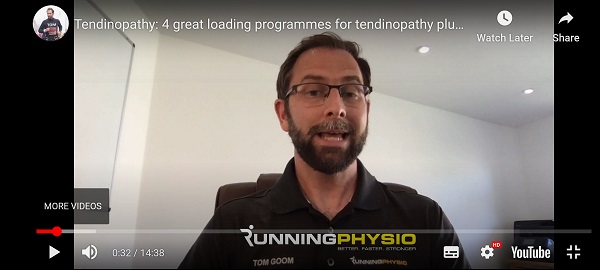
Tendinopathy: 4 great loading programs for tendinopathy
Please note that this page is mainly for my personal reference. My notes from viewing YouTube video https://www.youtube.com/watch?v=8GCBoaNztbA&t=643s
First loading option – Eccentric loading. Still most widely used approach for lower limb tendinopathy. Example – heel drops. Research in 90s showed good results but required 180 reps a day! As pain reduces then progress exercise by increasing loading. “Alfredson approach”
However, there are limitations. Requires about 5 hours per week to be compliant with protocol. So time consuming. Goom does not tend to use eccentric loading as go to.
Prefers – heavy slow resistance training. Starts at 15 reps and decreases to 6 by around 12 weeks. Time under tension helpful for tendon. Performed about 3 times a week means about less than 2 hours per week. May lead to greater collagen turnover and adaptation. Typical program – 3 exercise for the injured tendon. eg for hamstring one would focus on strengthening knee flexion role of hamstring, one of hip extension role and one with an eccentric bias.
Isometrics. Researched for pain by Ebony Rio. More recent by Seth O’Neill which tried to replicate Rio’s work but in achilles tendinopathy but the response was much more varied. Some improvement in some, some detriment in others. May have a role for some and might be appropriate as a starting point.
Clifford studied isometric versus isotonic exercise for greather trochanteric pain syndrome. Both appeared to be effective for reducing pain and improving function (but no between group difference) and a proportion showed no improvement. So if isotonics are provocative then isometrics may be way to go.
Goom prefers Combined approaches. Sancho study – 4 level progressive rehab isometrics calf and hip strengthening plus hopping for achilles tendinopathy. https://www.sciencedirect.com/science/article/pii/S1466853X19303116
Most approaches that work seem to include progressive loading and monitoring how that person responds.
Uncomfortable truth – about 40% of patients don’t get resolution of symptoms of loading programs. Kinesophobia may be an issue for some,